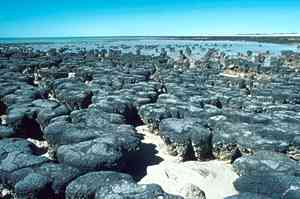|
|
Salinity
Environmental Factors
Salinity is not a problem on a shore covered each day by the waves, but is a critical factor in high-shore rock pools.
Many low-shore animals and algae may occur higher on a shore protected inside a permanently moist rock pool. Some rock pools are not often refreshed by seawater and are continually being dried out by the sun.
Here salinity reaches levels far saltier than seawater and the pools have become ecological deserts. You may find the remains of shore crabs or bleached mollusc shells. One species of mosquito larvae thrives in these super-saline pools.
Salinity becomes important in river estuaries, where freshwater is entering the sea. If a river floods annually, estuarine animals must be adapted to coping with an environment where the salinity changes. On some river shores affected by tides, there may be a daily washing with both freshwater and salty water.

Salinity is also important in embayments or locked-off lagoons, where water is being evaporated. The super-saline environment of Hamelyn Pool near Shark Bay in central Western Australia has favoured the extremely rare blue-green Stromatolites and has stopped them from becoming extinct.
In northern Australia, certain species of mangrove cannot grow on shores with a higher than normal salinity.
References
Bennett, I. (1987) W. J. Dakin's classic study: Australian Seashores. p. 3-12, Angus & Robertson, Sydney.
Davey, K. (1998) A Photographic Guide to Seashore Life of Australia. p.8, New Holland, Sydney.
Environmental
Factors
Latitude
Currents
Wind Effects
Wave Strength
Tidal Effects
Desiccation
Substrate
Turbidity
Salinity
Home
Page
Taxonomy
Biogeography
Rocky Shores
Tidal Levels
Intertidal Zonation
Environmental Factors
Biological
Factors
Feeding Relationships
Activities
Glossary
References
 Life
on Australian Seashores
Life
on Australian Seashores
by Keith Davey (C) 2000
Learning Consultant
- Media
The University of Newcastle
email at australian_seashores@hotmail.com
Scientific Consultant: Phil
Colman
site created 01.01.98 : updated 01.04.2000
